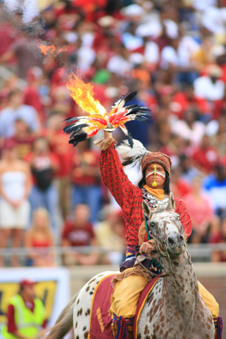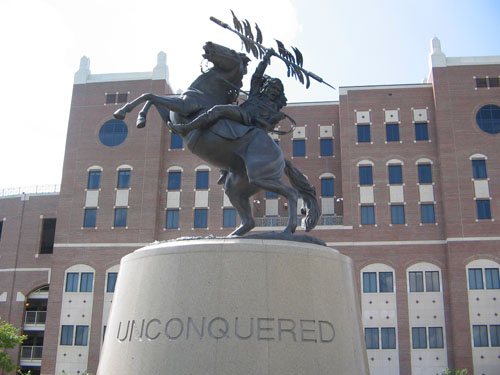
Osceola and Renegade
Seminole Traditions at FSU
By Jim Joanos
 |
Osceola and Renegade |
Recently, Florida State University's "Osceola and Renegade" rider and horse performance was declared as the best college football pregame tradition in the country. In a poll conducted over the internet by ESPN SportsNation and EA Sports, this FSU tradition won overwhelmingly over the others in the competition. This recent honor is one more fun, pleasant, and meaningful happening that has sprung from a decision made by the students at FSU nearly sixty-five years ago.
As early as 1902, there was an intercollegiate football team at Florida State (then named "Florida State College"). However, in 1905, the institution was converted into an all women's college. Consequently, the football program was disbanded. However, shortly after World War II ended the school became coeducational again and in 1947 was named The Florida State University. Immediately, intercollegiate football was reinstated.
Early in the 1947 season, the FSU team got a name. The name selected was "Seminoles" in honor of the native Americans who had fought so valiantly to retain their presence in Florida. Stories differ as to how the name was selected but nearly all accounts include a vote taken by the student body. There were apparently six names to choose from on the ballot. The others are believed to have been: "Golden Falcons," "Statesmen," "Crackers," "Senators" and "Indians." The Florida Flambeau, however, reported that the "Seminoles" won over, in order, "Statesmen," "Rebels," "Tarpons," "Fighting Warriors," and "Crackers." Apparently there were some write-ins.
Soon, logos bearing Seminole figures began appearing around the campus, on clothing, and in the media. In 1949, the FSU marching band also adopted the native American theme and took on the name, "Marching Chiefs." The official homecoming began being called the "Pow Wow." In the early fifties, the band had two of the best baton twirlers in the whole country. Dick Puckett and Ed Franklin, who wore Indian costumes, were known as "The Flying Seminoles." On some occasions, the cheerleaders wore skirts of Seminole Indian patchwork. In the late fifties and sixties, "Sammy Seminole," a student clad in Indian regalia, did flip flops and other gymnastic stunts along the sidelines to energize the fans during games.
 |
FSU Helmet |
Bobby Bowden was hired as the head coach in 1976. Shortly after that, a spear first appeared on the sides of the team's football helmets. The custom continues.
In September of 1978, Osceola and Renegade first appeared before FSU games. It was the project of Bill Durham, an alum, who first had the idea as a student in the early sixties. It did not get much support then but Coach and Mrs. Bowden in the late seventies supported it. Very carefully, Durham sought permission and approval from Howard Tommie, then Chairman of the Seminole Tribe of Florida. The tribal Seminoles not only approved but assisted in the development and even provided an authentic costume. Almost immediately, the performance became a smash hit. The tradition has grown. Today, it is widely recognized and enjoyed in college football warranting the recent accolades as the "best of them all."
Sometime during the 1984 season, some fraternity and band members began waving their arms in unison as some Indian-sounding strains of music were played over and over. Thus, the War Chant was born. It continues and is a valued component of home games.
 |
Unconquered Statue |
In 2003, "Unconquered," a magnificent, 13 1/2 feet high, horse and Seminole rider statute was unveiled in front of the University Center which houses Campbell Stadium. On nights before home games, the spear born by the bronze rider is ignited and cheers ring out as the flame appears. The flame is allowed to burn throughout the next day's game. The sculpture is the work of Fritz White, a Western artist known for his fine work with equestrian statutes. The idea came from another alum, Steve Reilly, who with funding supplied by The Seminole Boosters, led the project's development from beginning to end. The statue has become a must-see location for visitors to the the campus and a favorite location for graduating Seniors as well as incoming freshmen to have their pictures taken.
In 2005, the National Collegiate Athletic Association adopted something of a ban on the use of native American symbolism in collegiate. Fortunately, FSU was given a waiver due to the positive way in which the school utilizes its Seminole traditions and, most importantly because the Seminole Tribe of Florida supports FSU's use and methods. A lot of fans were very happy to get the waiver as the Seminole traditions have added so very much to FSU's athletics.
I, for one, am sure looking forward to that first game of the 2011 season and seeing Osceola slam that flaming spear into the turf. See you there.